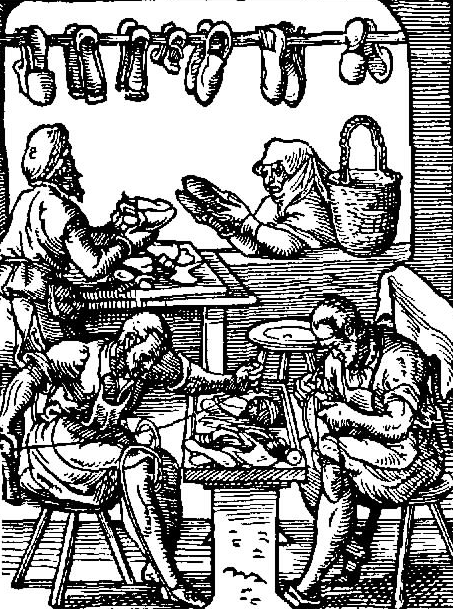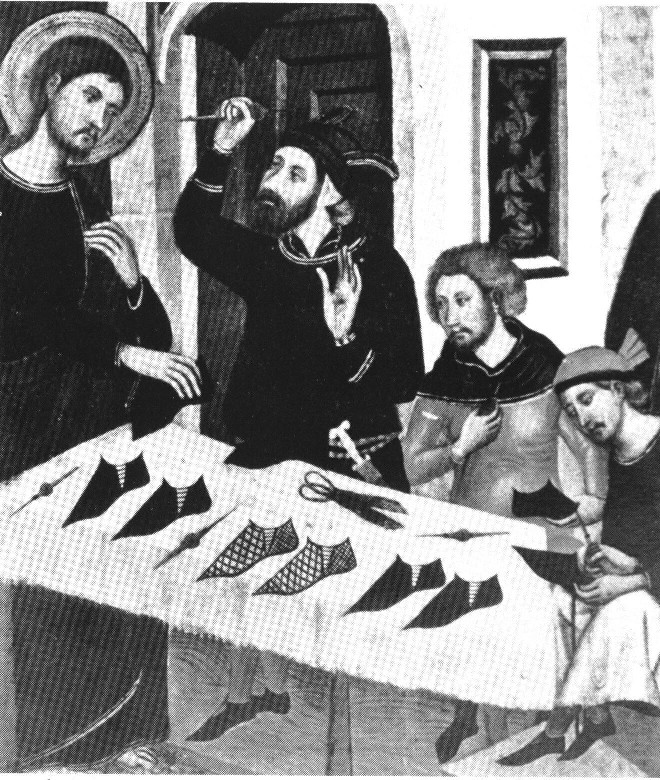Another essential tool (at least for me) used in many parts of the shoemaking process is the stirrup. The stirrup is basically a long, belt-like strap with a buckle in it to allow it to loosen and tighten. The idea is to act as a second pair of hands to hold something in place while you work on it. Let’s place the stirrup in historical context first, and then explain how I use it.
The earliest pictorial evidence of stirrup use that I know of is from the donor stained glass windows dated to 1205-1225 in the Chartres Cathedral of Notre-Dame. Both Marc Carlson and Larsdatter have several images of these and other images of shoemakers with (and without!) stirrups.
Many of the illustrations show the shoemaker strapping a shoe (or something – sometimes, we cannot tell) to the top of their knee or thigh, with the strap passing underneath the foot to provide tension.
Sometimes their foot is resting on a block, sometimes it isn’t. As you get into the 17th and 18th century, images of shoemakers with stirrups and blocks becomes more common (see Marc Carlson’s site for 17th century images and Garsault’s work on shoemaking for 18th century images), which is why we focus on the earlier representative images, such as the below image from the 14th century dipiction of the “Life of St. Mark” in the Manresa Cathedral, Spain.
For additional historical context, take a look at images from the 15th and 16th centuries below – both are woodcuts, and the first is dated to 1490. It is an image of Guy Marchand’s bookplate, Paris, 1496, and is a representation of St. Crispin and Crispianus, the two most commonly cited patron saints of shoemakers (October 25). The second is a 1568 woodcut from the “Eigentlicher Beschreibung aller Stände auf Erden,” by Jost Ammon and Hans Sack. Both show prominent use of the stirrup while shoemaking.

|

|
|
Unfortunately, for the most part, it is a bit difficult to see exactly what the shoemakers are working on – remember that the artists creating these woodcuts may only have had a vague notion of the shoemaker holding a shoe with the stirrup and sewing it with an awl and stitching cord. That is not to say that they were unfamiliar with the process, as all shoes were handmade at that point and it would not have been an uncommon sight at the market or a faire to see a shoemaker at work. Just as most people today have seen enough images of people on horseback to draw a representative image, when asked to draw a picture of a mounted rider, they might not capture all of the details of the harness, girth, spurs, etc. correctly. Perhaps the same is true with these images, but we digress.
The evidence above is not to indicate that everyone used stirrups – Das Hausbuch der Mendelschen certainly shows plenty of images of shoemakers cradling a shoe between their legs to work on it. But, I feel confident to say that there is ample evidence demonstrating the use of a stirrup from the medieval and beyond.
Speaking of which, what do we use the stirrup for? I’m so glad you asked:
– Closing the upper. That is, the pieces of the upper are butted together and attached with round closing (see this link on Al Muckhart’s site for a fine description of round closing). Essentially, the stirrup holds the two separate pieces upon a curved piece of wood so that the round closing stitches can be made by the shoemaker without having the work slide across his or her lap or the table.
– Tacking in a heel stiffener. In the same way that the closing block and stirrup assist with round closing, I find it very effective in whipping in heel stiffeners. The stiffener was found in many medieval and renaissance finds, as well as many early modern pieces.
– Inseaming and Outsoling (confused by these terms? Marc Carlson has an excellent dictionary which is good for referencing these confusing words!). As an example, and although it is not a primary source material, a drawing from a photograph of a 16th century sculpture of Crispin and Crispianus getting arrested shows the use of the stirrup with a shoe being stitched on one knee. I performing inseaming and outsoling with the shoe strapped to my knee in exactly this manner.
– Putting linen on bristles for sewing. Although I do not do this personally, Al Muckhart uses the stirrup to hold onto the bristle while he braids the linen threads around it. My technique of winding a bristle is different, as I wind the linen thread around the bristle, using my knees to tension it.
– Carrying your box of tools. I recreated an 18th C. journeyman’s box to carry the majority of my tools, and one of the curiosities was a small notch in the handle of the extant pieces. From discussion with the folks at Williamsburg who were kind enough to share these details, it appears that the journeyman would put his strap here and carry the entire box over his shoulder. The slot would keep the box level and prevent it from slipping off of the stirrup.
To perform properly, your stirrup should be of stout leather, and not stretch very much when tension is applied. I would say that a minimum of 7oz leather would suit. Additionally, you might not get a single piece long enough out of a hide very easily, so you might need to join two pieces with round closing or an overlap seam, and it’s hard to use a stirrup to do that if you don’t have one yet. If you do round close, I suggest putting a small piece of leather in between the two to help make the seam even stronger. This is a similar concept to the small strip of leather medieval shoemakers placed between the sole and the upper.


Hi Francis,
thank you very much for this great information on your site. My name means stirrup in English. I came upon your site in searching what my name would be in English. I am from Germany. I searched for family data and succeeded. I can go back in history until the year 1652… 🙂
“Knierim” is a mutilated version of “Knie-Riemen”. It means “Knee belt” i.e. “shoemaker’s stirrup”. Obviously, in Germany the same craftmens’ tools were used like in England in older days.
Best regards,
Hal Stirrup 😉
Hi Hal,
What a fantastic coincidence – absolutely, many of the same tools and techniques were used all over Europe, but there are slight differences between them all. For example, I am told that the Germans in the 16th century preferred the use of “sickle” style awls for inseaming as opposed to the standard curved awl common in other times. I have several of these awls, but I have never tried to use them! Perhaps your family was either shoemakers or cobblers.
Cheers,
Francis